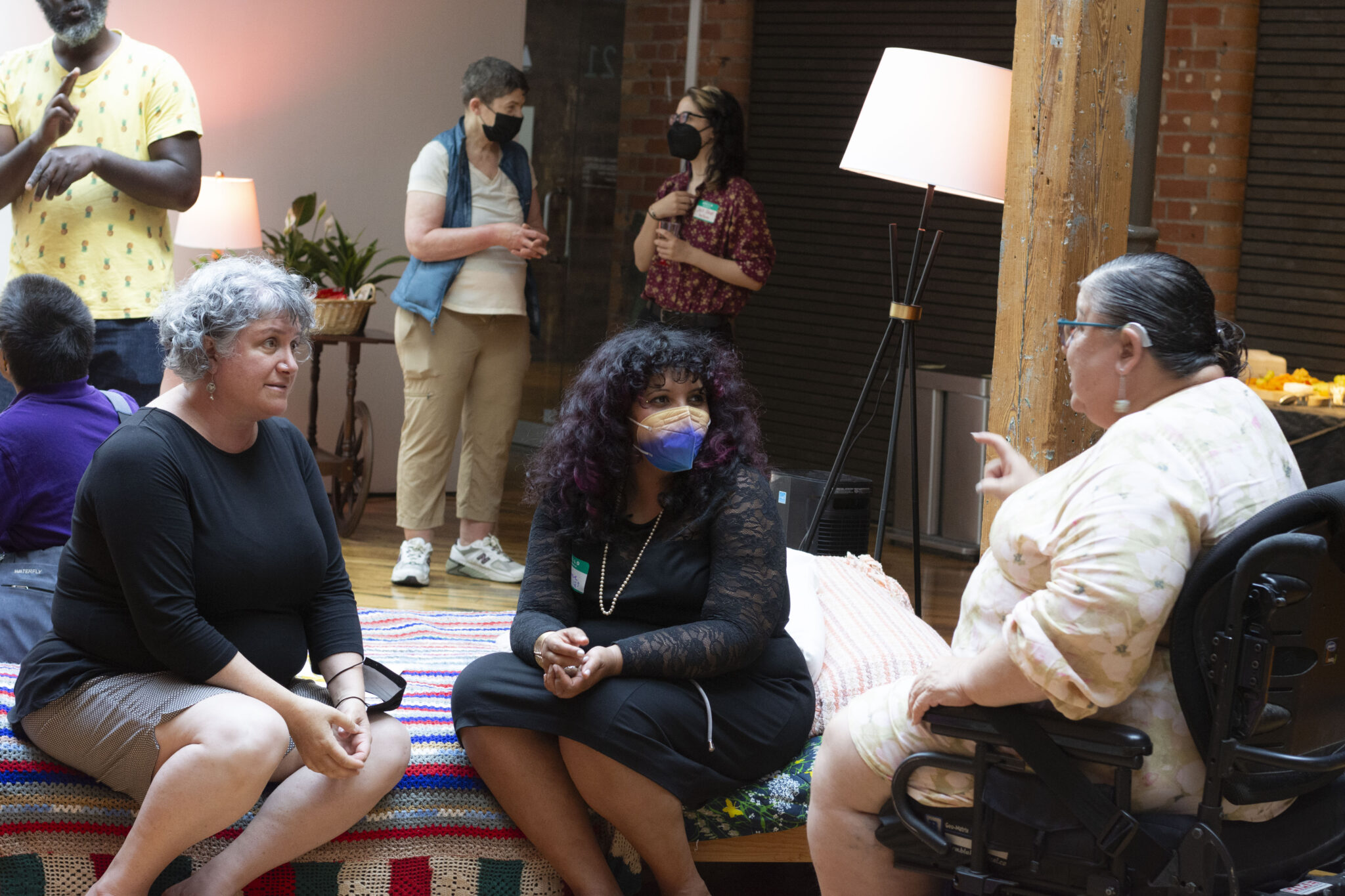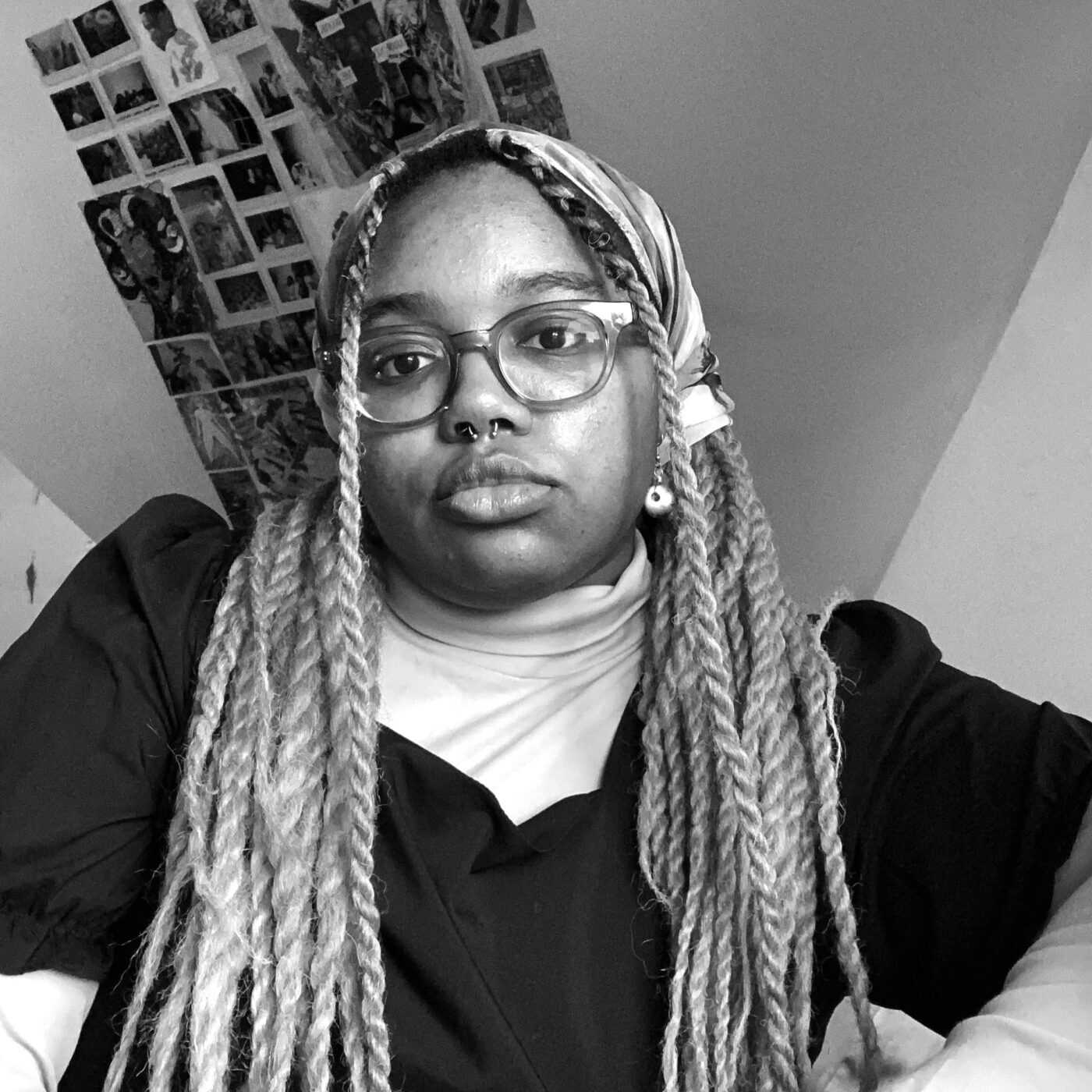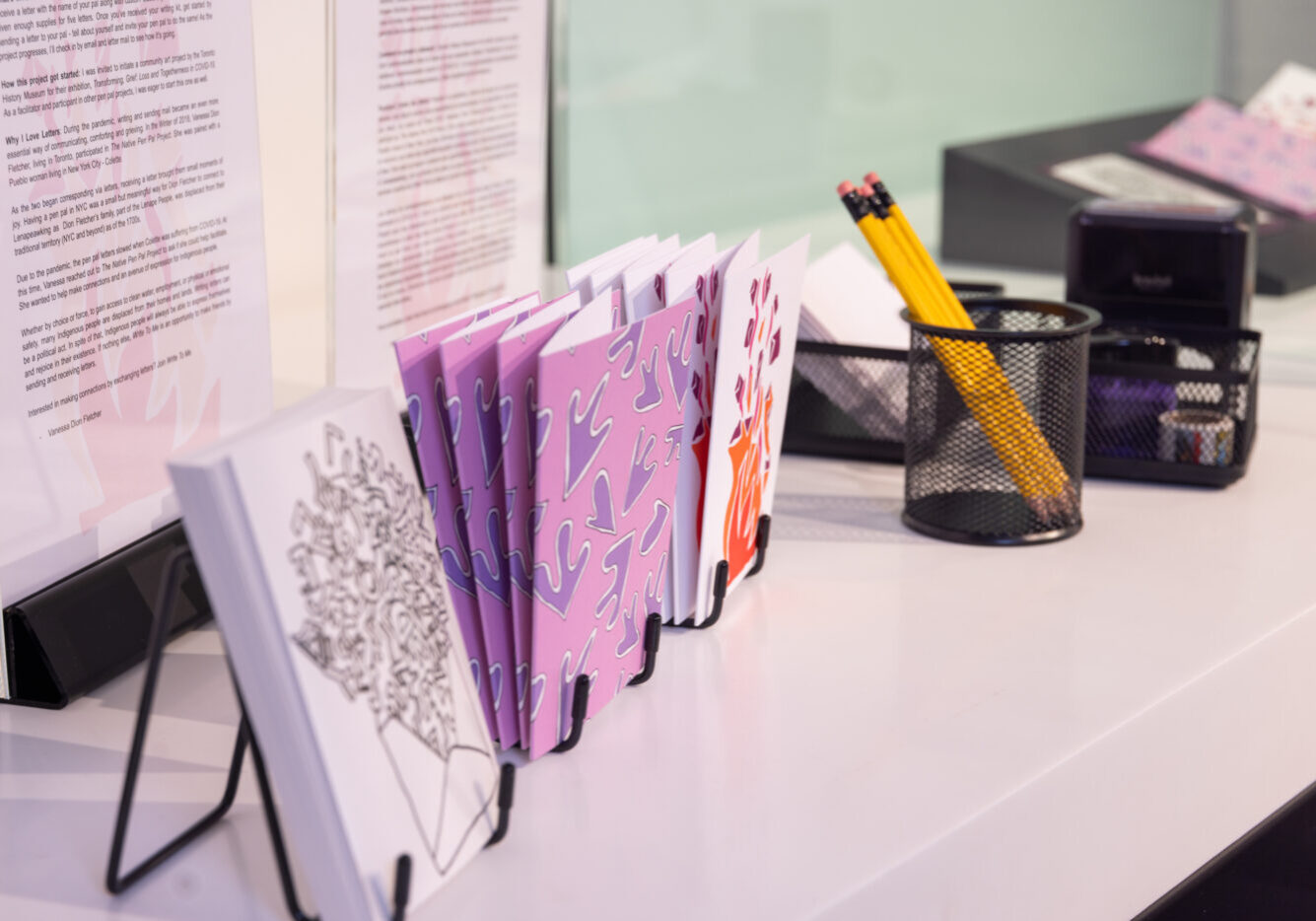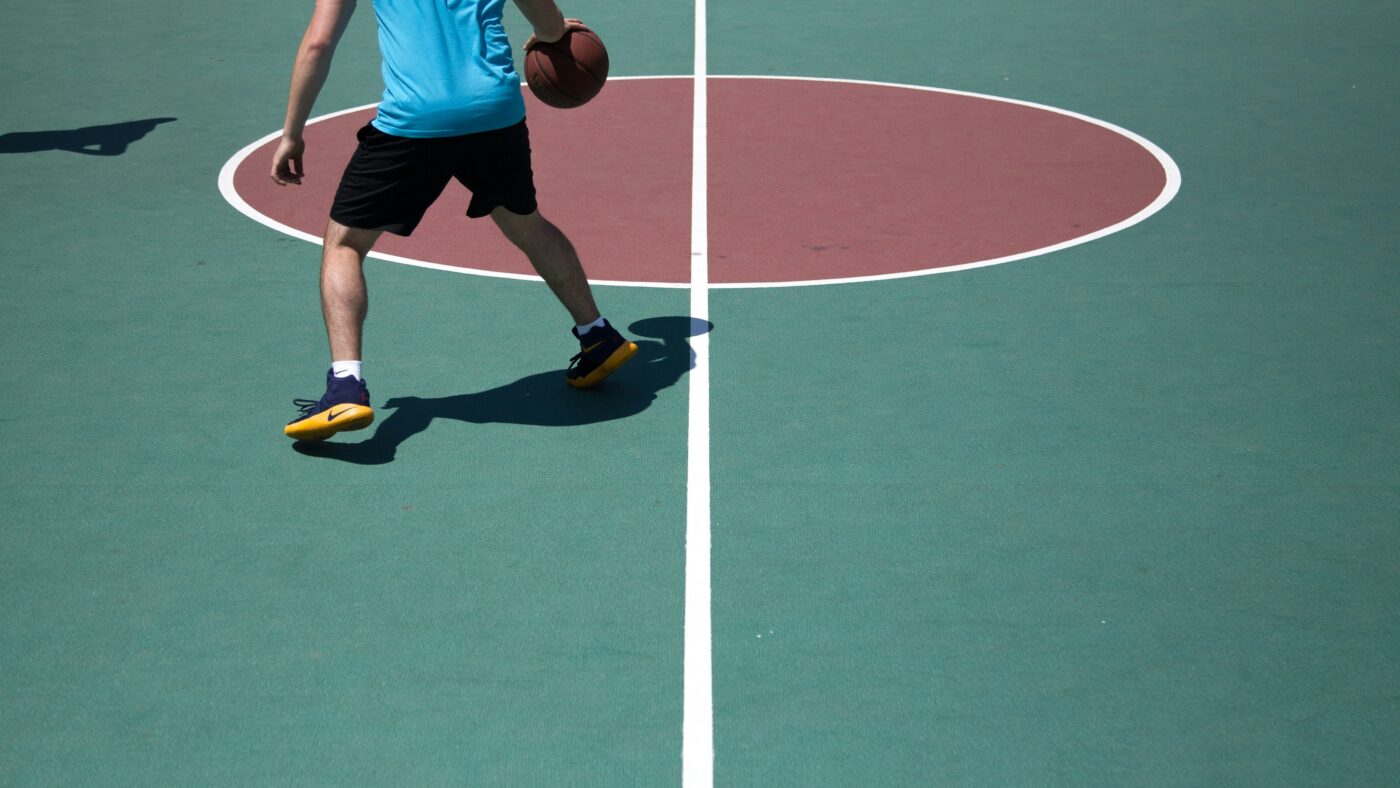How the disability arts movement made a home in Toronto
THE GREEN LINE
ORIGINAL STORY
How the disability arts movement made a home in toronto
For 50 years Mad, d/Deaf, and disabled artists and art lovers have been making space for their work and communities in this city.

Artist Salima Punjani welcomes guests to her exhibition, The Space in Between, at Trinity Square Video near Spadina Avenue and Richmond Street West.


Adele Lukusa
A graduate of TMU, Kitchener native enamoured with Toronto and lover of Jamila Woods. Currently working on supporting mutual aid efforts and unpacking the nuances of Black haircare.
December 5, 2023
Sama Nemat Allah, a writer and fourth-year student at Toronto Metropolitan University, says it felt like a “renaissance” when she first learned about disability arts through the university’s “Cripping the Arts” course.
“I've always been in art spaces, in community spaces like that,” said Nemat Allah, 21, who identifies as Mad and disabled. “This just felt like a renaissance for me…that [I can] actually put a name to all of the things I've been thinking about, dreaming about and writing about.”
Led by disability studies professor Eliza Chandler, the elective course is open to students in their third year and higher, and has served as a gateway into disability justice and arts for dozens of TMU students. That’s no coincidence, as Toronto has a rich history of disability activism and studies dating back to the 1970s; “Cripping the Arts” and the disabled-led gallery Tangled Art + Disability are outcomes of that work.
“All of our lectures were painted [with] these colours of access…everything felt like it was divorced from ideas like expediency that I think run and drive a lot of things in schooling, in institutions, in capitalistic spaces period,” Nemat Allah said, describing how accessibility shaped the course.
From thorough image descriptions in every slide to the lack of hard deadlines, “Cripping the Arts” was like no other class Nemat Allah says she’d taken to that point.
“It's not just about what we're learning,” she explained. “It was also the way that we were approaching the learning, right? It was like, ‘You can be as you are and you can come as you are to the learning.’”
“You can be as you are and you can come as you are to the learning.”
SAMA NEMAT ALLAH
21, WRITER AND FOURTH YEAR TMU STUDENT
“It's not just about the content. It's not just about what we're engaging [with] — it's also about how we're engaging it and the people that we're engaging in it with.”
This approach is also the difference between an average gallery experience and one informed by disability arts, like “Transforming Grief: Loss and Togetherness in COVID-19” at Fort York Visitor Centre, which showcases disabled artists such as the Crip Collective and mixed-media artist Vanessa Dion Fletcher. To “crip” the arts means to look at accessibility as a verb, as an act that goes beyond AODA guidelines. “Transforming Grief” encapsulates this approach, with large labels accompanying the art in English, French, Anishinaabemowin, Braille and American Sign Language. It also displays tactile artwork, provides headphones that attendees can use to listen to audio descriptions, and features a low-sensory room for neurodivergent folks who are sensitive to harsh lights and sounds. The term neurodivergent groups people whose brains work differently than the norm, such as those with ADHD and autism.
“Transforming Grief” is the essence of disability arts — that is, when both disabled artists and art appreciators alike are prioritized with intention and care. It’s for this reason that Nemat Allah and Dion Fletcher now identify as disabled artists, which encompasses a variety of experiences, including madness and d/Deafness.
The term Mad is a political identifier for anyone with experience in the psychiatric system, from ex-psychiatric patients, to people who regularly take prescribed selective serotonin reuptake inhibitors (SSRIs) and have regular therapy sessions. It aims to connect people who identify as Mad and bring them into a collective that can advocate for community-informed care beyond straightforward awareness campaigns and medical aid.
As for d/Deaf, the lowercase d typically addresses those whose first language was English and so are steeped in the hearing world; whereas the uppercase D refers to those usually born Deaf, whose first language is sign language and don’t see their Deafness as an impairment.

A CLOSE-UP OF ARTIST VANESSA DION FLETCHER'S "WRITE TO ME" INSTALLATION AT, A PEN PAL PROJECT FOR INDIGENOUS PEOPLE THAT LAUNCHED DURING THE PANDEMIC AS PART OF TRANSFORMING GRIEF: LOSS AND TOGETHERNESS IN COVID-19. CARDS, STAMPS, PENCILS AND STICKERS WERE AVAILABLE FOR PARTICIPANTS.

For Dion Fletcher, 36, identifying as a disabled artist was “really, really helpful in helping me build community.”
A Lenape and Potawatomi neurodiverse artist whose work spans video, performance and textiles, Dion Fletcher hadn't identified as disabled or neurodivergent until being invited to Chandler’s workshop at Re-Vision: Centre for Art and Social Justice, a research hub helmed by University of Guelph feminist studies and social practice professor Carla Rice. Because of that opportunity and others recommended to her by the disability arts community, Dion Fletcher was able to develop a network of like-minded artists.
“The social aspect of that was really affirming,” she said. “Seeing and hearing that there’s so many different stories and experiences…was kind of validating.”

SEAN LEE APPLIES A FACE MASK TO ARTIST SALIMA PUNJANI'S FACE AT ONE OF THE COMMUNITY DINNERS SHE HOSTED AS PART OF HER SHOW, THE SPACE IN BETWEEN.

It was through these kinds of events that Dion Fletcher was able to learn about Tangled Art + Disability, a nonprofit organization that doubles as a gallery space for disabled artists. The organization was born out of a festival organized by disabled artists and activists in the early 2000s, and is now housed at community-led artist hub 401 Richmond.
Programming director Sean Lee, 31, says Tangled also aims to create opportunities for artists to “become integrated or to have a bridge [into] the larger, mainstream art world.”
The gallery’s work transcends walls. Two years ago, thanks to a nomination from Tangled, Dion Fletcher won the Mayor’s Purchase Award at the Toronto Outdoor Art Fair. That, to Lee, is the essence of disability arts. “It's really about creating a space where folks feel like the sort of elitism and the barriers to [accessing] gallery spaces can be dissolved a bit. We're always constantly rethinking and reinterpreting how we create access for our space,” they said.
For example, at the time of the interview, Lee was working with an artist who has monocular vision to prioritize “blindness arts aesthetics” in the gallery space by exhibiting tactile art pieces and wooden blocks on the floor that can help cane users know where the art is displayed.
Although Tangled Arts + Disability is widely considered by participants to be the heart of this scene in Toronto, disability arts and artists can be felt across the city.
Salima Punjani, 37, a multisensory artist who works both here and in Montreal, describes Toronto’s thriving disability arts scene as deep-rooted.
“I often come to Toronto to fill my tank of social connections with other Mad, d/Deaf and disabled artists. I just find that there's a history there,” Punjani said. “I can't speak for anyone else, but I know that having folks like at Tangled is incredibly helpful because there's a hub, there's a place to go — a place that doesn't just work in silos of disability or madness or d/Deafness or anything.
“It's a space that's welcoming and that creates opportunities to spend time with other artists and to experience the work of other artists in a multi-sensory way.”
That’s why Punjani says it made a lot of sense to showcase “The Space in Between,” her latest Toronto show that explores her “love of the unspectacular” in the city. Held at Trinity Square Video this past summer, she hosted several community dinners for disabled artists. The conversations at those dinners were then recorded and turned into audio that could be felt as vibrations during her three-day exhibition in the gallery space, which was transformed into an elevated living room where attendees were invited to eat, chat and even lie in bed.
Punjani says “The Space in Between,” much like Toronto’s broader disability arts movement and history, is a love letter to her community and an ode to comfort. Masks were provided at the door, next to a table filled with fidget toys. There was also a poster that invited guests to indicate their social state; if you were in a chatty mood, you could don a fluffy orange string, but if you preferred folks kept their distance, then you could wear a rainbow ribbon.“I feel like being part of disability arts as a movement has invited me into spaces of dignity, where I feel like I'm listened to, where I feel like we're listened to,” Punjani explained. “I just feel like the hope for me comes from remembering what it's like to be treated with dignity.”
Fact-Check Yourself
Sources and
further reading
Don't take our word for it —
check our sources for yourself.
